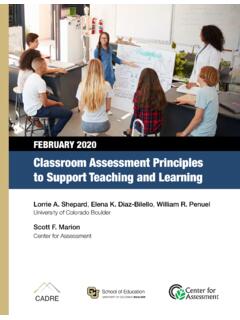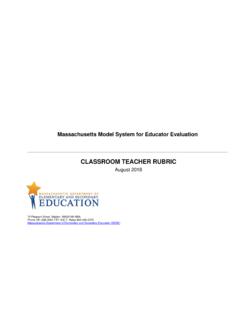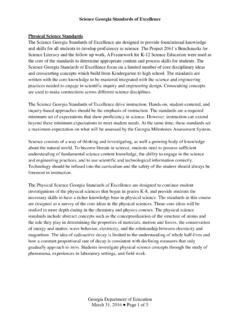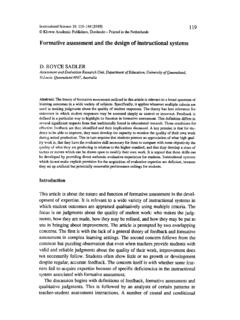Transcription of Formative Classroom Assessment and Benjamin S. Bloom ...
1 Formative Classroom Assessment and Benjamin S. Bloom : Theory, Research, and Implications Thomas R. Guskey College of Education University of Kentucky Lexington, KY 40506 Phone: 859/257-8666 E-mail: Paper presented at the Annual Meeting of the American Educational Research Association, Montreal, Canada. April 2005 Formative Classroom Assessment and Benjamin S. Bloom : Theory, Research, and Implications Abstract Although much recent attention has focused on gaps in the achievement of different groups of students, the problem has been with us for decades.
2 This paper presents the problem as one of reducing variation in students achievement, and reviews the work of renowned educator Benjamin Bloom on this problem. Bloom argued that to reduce variation in students achievement and to have all students learn well, we must increase variation in instructional approaches and learning time. The key element in this effort was well constructed, Formative Classroom assessments. Bloom outlined a specific strategy for using Formative Classroom assessments to guide teachers in differentiating their instruction and labeled it mastery learning.
3 This paper describes Bloom s work, presents the essential elements of mastery learning, explains common misinterpretations, and describes the results of research on its effects. Formative Classroom Assessment and Benjamin S. Bloom : Theory, Research, and Implications Achievement gaps among different groups of students have concerned government and educational leaders for many years. In the 1960s, President Lyndon Johnson s War on Poverty focused directly on inequalities in the educational achievement of economically disadvantaged students and their more advantaged counterparts.
4 The Economic Opportunity Act (EOA) of 1964, which established the Head Start program, and the Elementary and Secondary Education Act (ESEA) of 1965, which created the Title I and Follow Through programs, were specific attempts to address these gaps in educational attainment. More recently, the No Child Left Behind (NCLB) legislation ( Congress, 2001) revived these concerns. The law requires schools to report achievement results separately for various poverty, ethnicity, language, and disability subgroups. Not only must schools identify any achievement gaps among these different student subgroups, they also must take specific steps to close them.
5 Over the years educational researchers have learned a lot about reducing these achievement disparities. Yet because of our tendency in education today to focus only on what s new, a lot of that important knowledge is being neglected. Instead of building on what we already know, many modern proposals for closing achievement gaps simply rename well-established principles, adding to the tangled thicket of terminology that confounds progress in education. To succeed in our efforts to close achievement gaps and to reach our goal of helping all students learn well, we need instead to recognize and extend this hard-earned knowledge base.
6 Researchers Views Researchers do their best to view problems in their simplest and most basic form. From a researcher s perspective, therefore, achievement gaps are simply matters of variation : students vary in their levels of achievement. Some students learn excellently in school and reach high 1levels of achievement, while others learn less well and attain only modest levels. Whenever we measure two or more students achievement, we also measure this variation. Researchers design studies to explain variation.
7 They make educated guesses, called hypotheses, about what factors contribute to the differences among individuals. Then they manipulate those factors in carefully planned investigations to determine the effects. When they find a relationship between the factors that they manipulate and differences in outcomes, they succeed in their efforts to explain variation. One of the early researchers concerned with explaining variation in student achievement was Benjamin S. Bloom . In the early 1960s, Bloom s studies focused on individual differences, especially in students school learning.
8 While he recognized that many factors outside of school affect student learning ( Bloom , 1964), his investigations showed that teachers have potentially strong influence as well. In his observations of classrooms, Bloom noted that most teachers included little variation in their instructional practices. The majority taught all students in much the same way and provided all with the same amount of time to learn. The few students for whom the instructional methods and time were ideal learned excellently. The largest number of students for whom the methods and time were only moderately appropriate learned less well.
9 And students for whom the instruction and time were inappropriate due to differences in their backgrounds or learning styles, learned very little. In other words, little variation in the teaching resulted in great variation in student learning. Under these conditions the pattern of student achievement was similar to the normal curve distribution shown in Figure 1. B A F D C Figure 1. Distribution of Achievement in Traditional Classrooms To attain better results and reduce this variation in student achievement, Bloom reasoned that we would have to increase variation in the teaching.
10 That is, because students varied in their learning styles and aptitudes, we must diversify and differentiate instruction to better meet their individual learning needs. The challenge was to find practical ways to do this within the constraints of group-based classrooms so that all students learn well. In searching for such a strategy, Bloom drew primarily from two sources of evidence. First he considered the ideal teaching and learning situation in which an excellent tutor is paired 2with each student. He was particularly influenced by the work of early pioneers in individualized instruction, especially Washburne (1922) and his Winnetka Plan, and Morrison (1926) and his University of Chicago Laboratory School experiments.
















